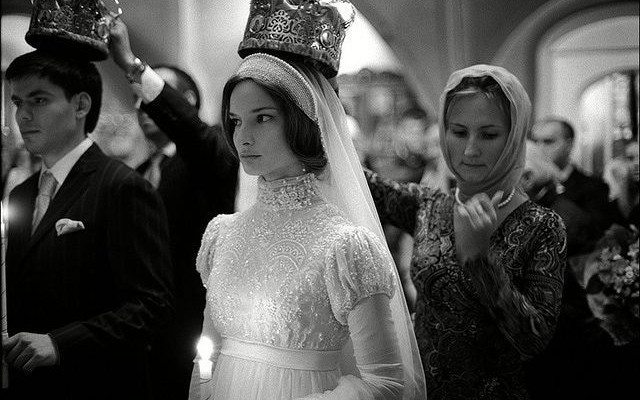Despite its many (and sometimes jarring) cultural changes, Russia enjoys many wedding traditions reaching far back in time. True,
the ceremony itself is relatively devoid of them in this post-Bolshevik age, but the reception is a different matter in which the oldest,
most opulent customs are still going strong.
At this stage, Russian law no longer recognizes church weddings, so couples that wish to marry must go through a civil wedding ceremony. At the end of it, the couple is handed bread and salt, which represents health and prosperity. Despite this small nod to tradition, most family members consider the civil ceremony a mere formality, and give it a pass. Within the culture, the two-day extravaganza of a reception is considered far more important than the ceremony itself.
Despite its relative insignificance to family members and guests, the civil ceremony involves some effort on the part of the bridal couple. First of all, the day begins with the bride and groom ensconced in different camps, each surrounded by their own family and friends. And then the games begin. The groom, you see, will start to make his way toward the bride long before the civil ceremony is scheduled to begin. Why? Because the bride’s friends and family will try to block him.
For example, let’s say the bride lives on the top floor of a tall apartment complex. In this case, the unfortunate groom will be stopped at each floor by the bride’s party and interrogated — perhaps he’ll be asked trivia questions about his intended. But if he answers them wrong, he’ll have to reach into his pocket and fish out some cash to get to the next floor.
Once he’s cleared these hurdles, the bride and groom will then travel by train to the site of the civil service, but in separate cars. Only the closest friends and family will join him at this stage, since the ceremony’s considered so unimportant.
Immediately after the ceremony, the couple then embarks on a tour of the city to visit the graves of those who have died in service. This stage of the tour usually lasts two to three hours, during which the couple honors those killed in wars by laying flowers at the foot of their memorials. Again, the couple is typically alone, except for the two people who served as witnesses at the civil ceremony. Occasionally one or two other close friends will accompany them, but the family rarely does because they’re so busy preparing for the reception.
After the tour of the city and the honoring of the dead, the couple finally arrives at the reception — and this is where the true festivities begin. Always, the reception begins with a toast — typically, the parents are the first to toast the bride and groom. Then, the rest of the guests follow suit.
It’s during the toasts that you begin to see Russian tradition coming alive. After each toast, the guests sip their wine, then shout, “Gor’ko,” meaning bitter. It’s up to the couple to sweeten the wine — by kissing. Needless to say, guests indulge in this tradition after each and every toast, and ultimately wrangle a lot of kissing from the couple.
The remainder of the night one is filled with exuberant dancing, plus another unique Russian tradition of “kidnapping.” The friends of the groom take advantage of the chaos on the dance floor by making away with the bride. They then demand that the hapless groom pay a ransom for her recovery.
Sure enough, the bride’s friends get in on the fun by “stealing” the bride’s shoes, and once again, the groom pays a ransom to get her shoes back. Day one continues on late into the night, both delighting and exhausting the guests.
The second day of a traditional Russian wedding is usually much more relaxed, and takes place at the house with a couple will start their lives together. Although politeness dictates that anyone from day one is invited, usually only close friends and family members join this more intimate day of celebration.
With a nod to the demands of the night before, day two of a Russian wedding usually starts in the late afternoon or early evening. First of all, the guests enjoy a meal together. Then, after the meal, the bride fulfills another Russian tradition by cleaning the floor.
This isn’t as arduous or unpleasant as it sounds, though; the guests will “litter” the floor with paper money and coins, and it’s the bride’s happy duty to tidy up by scooping up the money. The guests are free to continue littering while the bride is busy cleaning, and most people particularly love to bring out large bags of coins to scatter, making the bride’s job as difficult as possible. Despite the humor, this tradition lets guests make a meaningful contribution to the newlyweds.
So there you have it — the traditional Russian wedding amounts to two exuberant days of food, drink, humor and friends. As mentioned, the ceremony amounts to a mere afterthought, since the government only recognizes marriages that take place through the civil service. In fact, a couple set on a church service will have to marry to the civil service ahead of time. As a result, even when a church ceremony is involved, the reception is typically the heart and soul of a traditional Russian wedding.


